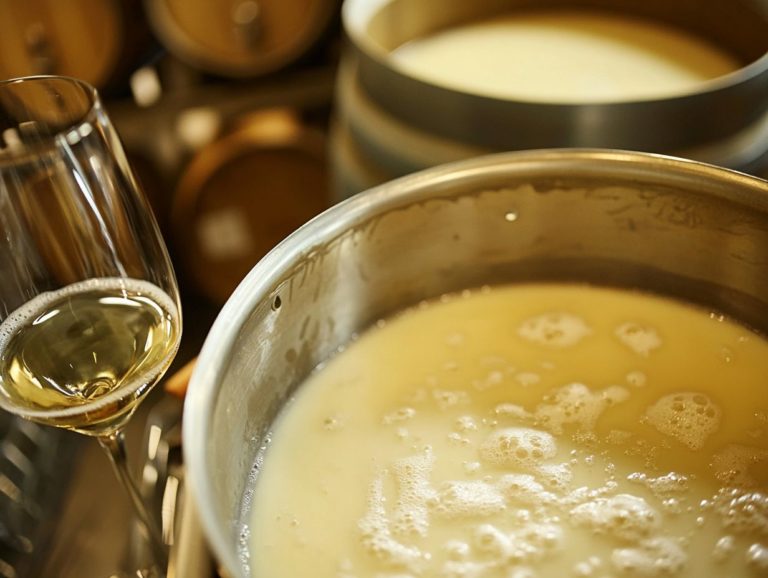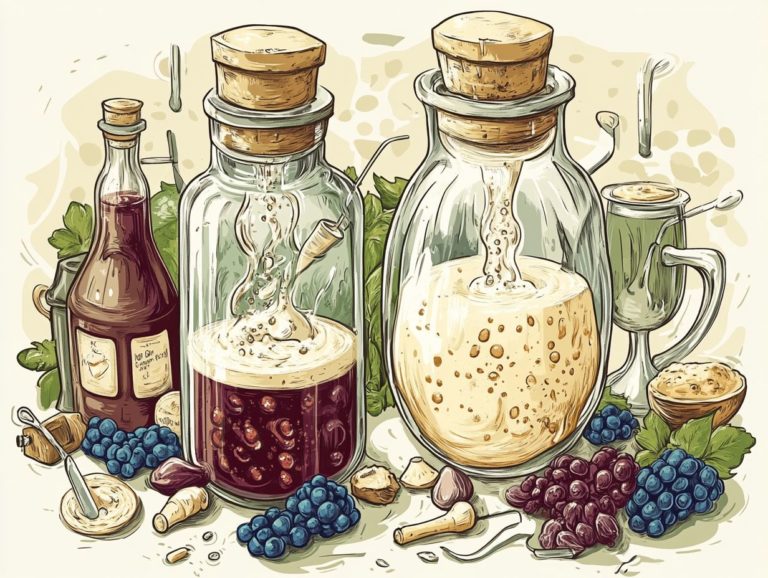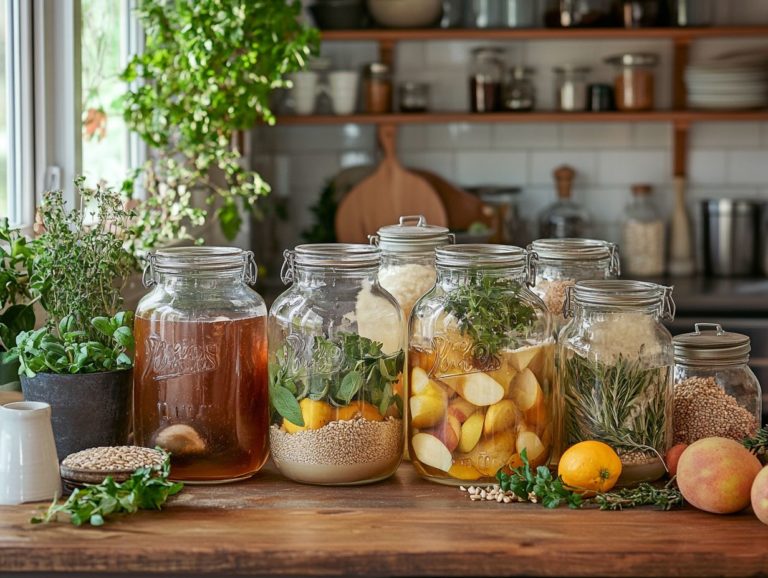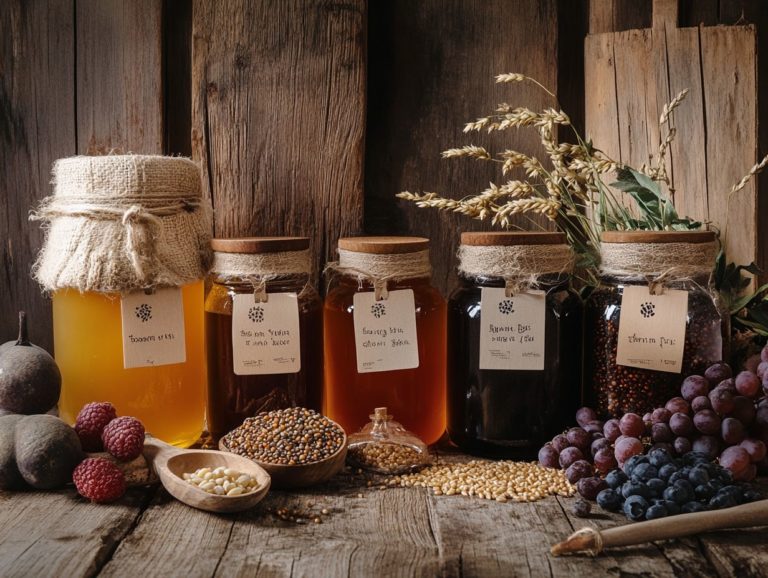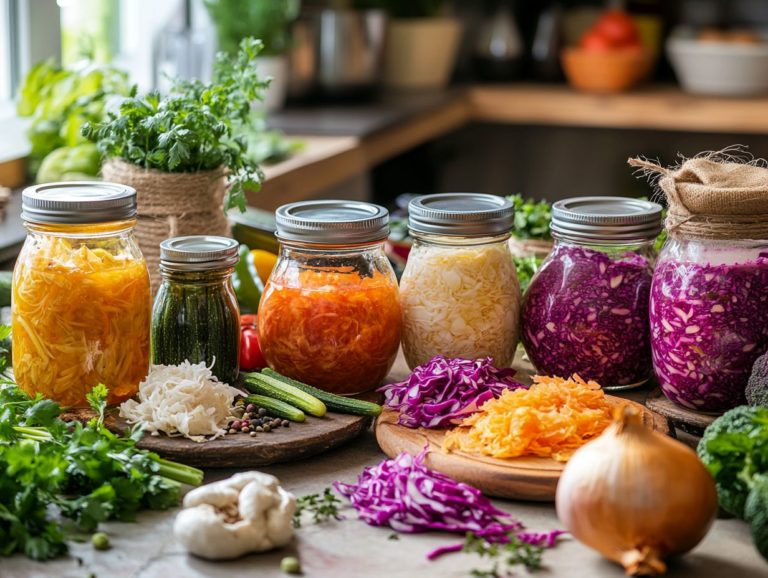The Science of Fermentation: A Brewer’s Guide
Fermentation transforms raw ingredients into exquisite beverages. It showcases the delicate interplay between science and artistry in brewing.
This guide covers the essentials of fermentation. It highlights the vital role of yeast, enzymes, and other microorganisms in brewing.
You will navigate each step of the fermentation process. Discover the factors that can influence it and learn how to troubleshoot common challenges.
Whether you re an aspiring brewer or intrigued by the science behind your favorite drinks, this guide provides valuable insights into the fascinating world of fermentation, brewing science, and the innovative techniques used in the craft beer industry.
Contents
- Key Takeaways:
- The Basics of Fermentation and Brewing Practices
- The Science Behind Fermentation
- The Fermentation Process
- Step 1: Mashing
- Step 2: Boiling and Hopping
- Step 3: Cooling and Pitching Yeast
- Step 4: Fermentation
- Factors Affecting Fermentation
- Troubleshooting Fermentation Issues
- Frequently Asked Questions
- What is fermentation and how does it relate to brewing science?
- Why is understanding the science of fermentation important for craft brewers?
- How does temperature affect the brewing process and fermentation?
- Do all beers go through the same fermentation processes?
- Can fermentation be affected by other factors besides temperature in the brewing process?
- Is fermentation the only step in the brewing process that involves microorganisms?
Key Takeaways:
- Fermentation is a crucial process in brewing, where yeast converts sugars into alcohol and carbon dioxide, often taking place in vessels such as barrels or wooden vessels.
- Understanding the science behind fermentation, such as the role of yeast, enzymes, and other microbes, can help brewers produce better quality beer.
- Factors like temperature, pH level, nutrient availability, and yeast strain selection can greatly affect the fermentation process and should be carefully monitored.
The Basics of Fermentation and Brewing Practices
Fermentation is a fascinating biological process that transforms sugars into alcohol and carbon dioxide. This gives rise to beer and other delightful fermented beverages a practice rich in history and tradition, significantly impacting the brewing industry.
This intricate process involves various microorganisms, primarily yeast varieties like Saccharomyces cerevisiae (a common type of yeast used in brewing) and Brettanomyces. These are essential for developing the complex flavors and aromas that define craft beer.
By grasping the fundamentals of fermentation, you gain valuable insight into the brewing process. Understanding how different ingredients such as malt, hops, and water influence the final product enables you to craft unique and innovative beers that appeal to a wide range of tastes.
What is Fermentation and Its Role in Brewing Practices?
Fermentation is a fascinating biological process in which microorganisms primarily yeast and bacteria transform sugars into alcohol and carbon dioxide, which is a cornerstone of brewing.
This intricate biochemical reaction showcases various types of yeast, particularly Saccharomyces cerevisiae, which flourishes in sugary environments. It spearheads the primary fermentation that converts malted grains into beer.
But it doesn’t stop there; lactic acid bacteria and other microorganisms can also contribute, especially in sour beer styles. This emphasizes the rich tapestry of flavor profiles that fermentation can create.
The significance of this process transcends mere alcohol production. It shapes the aroma, taste, and mouthfeel of the final brew.
By grasping the science behind fermentation, you can manipulate conditions like temperature, pH, and storage conditions. This effectively customizes the beer’s characteristics to align perfectly with your vision.
Why is Fermentation Important in Brewing and Craft Beer Production?
Fermentation is absolutely crucial in brewing. It shapes the flavor profile, alcohol content, and overall character of the beer you produce.
This intricate process enriches the depth and complexity of various tastes. It also plays a vital role in developing unique aromas that can transform a simple brew into an extraordinary experience, significantly contributing to the craft beer industry.
Different yeast strains, whether they re ale or lager yeasts, bring their own distinct characteristics that define a beer’s identity. For example, certain yeasts can enhance fruity or spicy notes, adding layers to your drinking experience.
The fermentation temperature and duration significantly influence how flavors evolve. Pay attention to these details to craft your signature brews!
The Science Behind Fermentation
The art of fermentation is a fascinating interplay of yeast, enzymes, and various brewing ingredients. They collaborate to produce the rich flavors and aromas that define exceptional beer.
Gaining a deep understanding of these intricate processes is essential for you as a brewer. This knowledge allows you to innovate and elevate your craft.
The Role of Yeast in Fermentation
Yeast serves as the backbone of fermentation. It plays a pivotal role in transforming sugars into alcohol and carbon dioxide an essential process for crafting exquisite beer and other fermented beverages.
You ll find that different types of yeast impart distinct characteristics to the final brew, influencing both flavor and aroma. Take Saccharomyces cerevisiae, for example. This popular ale yeast tends to ferment at warmer temperatures, resulting in fruity esters and phenolic flavors that enrich the complexity of your beer.
In contrast, Saccharomyces pastorianus, frequently used for lagers, ferments more slowly at cooler temperatures, delivering a clean and crisp profile.
You can also embrace wild yeasts and various strains to introduce sourness and add depth to your creation. Your choice of yeast not only affects alcohol production but also shapes the very essence of the beer’s character. This practice is explored in texts like Wood & Beer: A Brewer s Guide by Dick Cantwell and Peter Bouckaert.
The Role of Enzymes in Fermentation
Enzymes play a crucial role in fermentation by breaking down complex carbohydrates into simpler sugars. This transformation facilitates the brewing process.
This step is vital for alcohol production, as yeast eagerly consumes the sugars released during this process and converts them into ethanol and carbon dioxide.
Among the key players in this enzymatic breakdown are amylases, which specifically target the starches found in malted grains. They turn these starches into fermentable sugars.
Proteases also contribute significantly by breaking down proteins. This process not only enhances the clarity of the beer but also improves foam stability and mouthfeel.
Their delicate balance ensures that during fermentation, yeast has an ample supply of fermentable sugars to thrive. This ultimately influences the flavor, aroma, and overall quality of the final beer product.
The Fermentation Process
The fermentation process in brewing encompasses several essential steps. It begins with mashing the grains to extract fermentable sugars.
This is followed by boiling, cooling, and ultimately pitching yeast to kickstart fermentation.
Throughout this meticulous journey, you must carefully control temperature, quality, and storage conditions. This creates the optimal conditions for yeast activity.
This attention to detail shapes the beer’s character and flavors.
Understanding each step of this thrilling process empowers you to craft exceptional beers! Master these techniques, and you ll be on your way to creating beers that will impress and delight your friends and family!
Step 1: Mashing
Mashing is your starting point in the fermentation journey. Heated water mingles with crushed grains to activate enzymes that transform starches into fermentable sugars.
This stage lays the groundwork for sugar extraction. It also demands meticulous temperature control to optimize how enzymes work. Typically, maintaining temperatures between 140 F to 160 F (60 C to 71 C) is essential, as this range favors specific enzymes. For example, alpha-amylase flourishes at the higher end, breaking down complex carbohydrates. Meanwhile, beta-amylase performs best in cooler conditions, yielding maltose.
Your choice of grains be it barley, wheat, or corn plays a significant role in shaping the outcome, with each variety imparting its distinct flavors and characteristics. By ensuring proper mashing, you maximize the yield of fermentable sugars. This ultimately influences the quality and flavor profile of your final alcoholic creation, whether it be beer or whiskey.
This step is crucial for brewers eager to create standout flavors in the market.
Step 2: Boiling and Hopping
Boiling is the essential second step in your brewing journey. Here, the wort is heated to sterilize it and extract the delightful flavors from hops. Hops play a pivotal role in the beer’s aroma and bitterness.
This process typically unfolds over about an hour. During this time, you can introduce various hop varieties at different stages to optimize bitterness and elevate the overall flavor profile. For instance, by adding bittering hops earlier in the boil, you create a robust backbone. Later additions of aromatic hops can infuse vibrant floral or citrus notes that tantalize the palate.
Techniques like dry hopping and using different hop varietals, such as Cascade or Saaz, showcase creativity and complexity in the brewing process.
Your choice of hop varietals, whether it s the fragrant Cascade or the noble Saaz, significantly influences the final product. These hops impart unique characteristics that define different beer styles. By managing the boiling and hopping process with care, you achieve the desired flavor complexities and ensure stability. This helps your beer maintain its quality throughout the brewing process and into the bottle.
Esteemed figures like John D. Sheppard and Karl Ockert have extensively studied these brewing practices, enhancing beer production quality.
Step 3: Cooling and Pitching Yeast
Cooling the wort after boiling is an essential step in preparing it for yeast pitching. This ensures the temperature is just right for fermentation to kick off.
Proper cooling techniques are vital. They maintain the quality and stability of the beer during storage and transportation. This cooling process is crucial for bringing the wort down to a safe temperature while preventing off-flavors that can develop from prolonged heat exposure.
Rapidly cooling the wort helps preserve the delicate aromas and flavors derived from the hops and malts. It safeguards against any unwanted taste characteristics introduced by high temperatures.
Once cooled to the optimal range, typically between 65 F to 75 F, you can effectively pitch the yeast. This sets the stage for a vigorous fermentation process. Proper temperature control during this critical stage lays the groundwork for a clean, flavorful brew, highlighting the importance of meticulous attention to your cooling techniques.
Step 4: Fermentation
The fermentation step is where the true artistry unfolds. Yeast takes center stage, metabolizing the sugars in wort to produce not only alcohol and carbonation but also a captivating array of flavors that define the beer.
During this crucial phase, maintaining precise temperature control is essential for optimizing yeast performance and, consequently, the overall profile of your beer. Warmer temperatures encourage the development of fruity esters, while cooler conditions typically lead to a cleaner finish.
Different yeast strains each bring their unique flair to the beer’s complexity. Ales, for example, often utilize top-fermenting yeasts that flourish at higher temperatures, resulting in bold and robust flavors. In contrast, lagers depend on bottom-fermenting strains that thrive in cooler environments, lending a refreshing, crisp character to the brew.
The fermentation environment also influences yeast activity. Factors such as oxygen levels and pH ultimately shape the aromatic and taste characteristics of the final product.
Step 5: Conditioning and Packaging
Conditioning and packaging are the final touches in the brewing process, allowing your beer to mature and develop its unique flavors before it makes its way to you.
During conditioning, brewers pay close attention to elements like time, temperature, and techniques such as dry hopping or lagering (a process that involves storing beer at low temperatures). These factors can dramatically influence the overall profile, aroma, and mouthfeel of the beer. Effective time management is crucial; it ensures that the flavors meld beautifully, creating a harmonious tasting experience.
The choice of packaging whether it s bottles, cans, or kegs also plays a vital role in preserving freshness and preventing oxidation.
The right packaging not only safeguards the beer but also elevates its visual appeal, which can significantly affect your perception and enjoyment of the beverage.
Factors Affecting Fermentation
Numerous factors significantly impact fermentation in brewing, and each one plays a crucial role in achieving the beer characteristics you desire. Maintaining a consistent fermentation temperature can greatly enhance yeast performance. The pH level also influences enzyme activity, which ultimately contributes to the beer s flavor profile.
Choosing the right yeast strain can dramatically transform the final product s aroma and taste, showcasing the intricate nature of the fermentation process within the craft beer industry.
Temperature
Temperature plays a crucial role in fermentation, shaping yeast activity and influencing fermentation speed. It also guides the flavor development in your beer.
Different yeast strains flourish within specific temperature ranges; for example, ale yeasts typically perform best between 68 F and 75 F, while lager yeasts prefer cooler conditions around 45 F to 55 F. These temperature variations not only dictate how quickly fermentation occurs but also significantly affect the flavor profiles of your brew.
Higher temperatures can amplify fruity esters and phenolic compounds. This results in a complex and sometimes spicier profile.
In contrast, lower temperatures often lead to a cleaner, crisper taste. Therefore, grasping and controlling fermentation temperature is essential for you as a brewer, especially when striving to achieve your desired outcomes in every batch.
pH Level
The pH level of the wort plays a crucial role in fermentation, directly influencing both yeast performance and enzyme activity.
When you maintain the pH within the optimal range, typically between 5.2 and 5.6, enzymes function at their best, effectively breaking down starches and sugars. This process ultimately enriches the flavor profile of your beer.
If the pH strays too far from this sweet spot, fermentation can slow to a crawl. Sluggish yeast activity can lead to less-than-ideal flavor extraction, resulting in off-flavors that detract from the intended character of your final product.
It s essential for you to closely monitor and adjust the pH throughout the brewing process. Doing so ensures you maximize the efficiency of chemical processes and cultivate the desired flavors that will elevate your brew.
Nutrient Availability
Nutrient availability is crucial for achieving healthy fermentation, as yeast relies on a variety of nutrients to flourish and create exceptional beer.
Understanding the pivotal roles of different nutrients in this process can profoundly influence the final product. Among the most essential nutrients are nitrogen, vitamins, and minerals.
Nitrogen sources, such as ammonium and amino acids, serve as the foundational building blocks for yeast growth and reproduction. Vitamins like biotin and thiamine support metabolic processes, ensuring that yeast cells remain active and healthy throughout fermentation.
Additionally, essential minerals, including magnesium and zinc, play a key role in enzyme function and the stability of cell membranes.
Ensure your yeast has access to these vital nutrients to foster a vigorous fermentation. This will dramatically enhance the flavors and aromas of your beer, making each sip a delight!
Yeast Strain Selection
Choosing the right yeast strain is crucial in your brewing journey. Different strains impart distinctive flavors and aromas to your final beer product, making it unique and enjoyable.
Understanding the intricacies of yeast selection can elevate your craft to new heights. Each strain adds its own unique character to various beer styles. For example, the classic Saccharomyces cerevisiae is celebrated for its role in producing ales, offering fruity esters (chemical compounds that can influence aroma and taste) and a complex aroma profile that enhances beloved beverages like IPAs and Belgian ales.
On the other hand, the refined qualities of Saccharomyces pastorianus are essential for lager production, delivering the clean, crisp finishes that define this style.
Then there are the specialty strains, such as Brettanomyces, which introduce a distinctive funkiness, making them sought after for sour ales and barrel-aged beers. By thoughtfully selecting your yeast strains, you can truly personalize your creations, achieving a harmonious balance of flavor and texture that resonates with your vision.
Troubleshooting Fermentation Issues
Troubleshooting fermentation issues is essential for you as a brewer, given that a range of problems such as off-flavors, stuck fermentation, and infections can drastically impact the quality of the beer you produce.
By identifying these issues early in the brewing process, you can implement corrective measures that ensure your final product aligns with the high standards and flavors expected of expertly crafted beer.
By gaining a deeper understanding of common fermentation problems and their solutions, you enable yourself to refine your brewing practices and uphold exceptional quality standards.
Off-Flavors and Aromas
Off-flavors and aromas during fermentation can be a real headache, often stemming from yeast stress, contamination, or less-than-ideal fermentation conditions.
These unwelcome traits can seriously undermine the overall quality and appeal of your beer, potentially turning consumers away and tarnishing your brewery’s reputation.
Common offenders include excessively high fermentation temperatures, which can lead to the production of esters and fusel alcohols (chemical compounds that can influence aroma and taste). This can introduce fruity or overly alcoholic notes that stray from your original vision.
If your brewing equipment isn t sanitized properly, bacteria or wild yeast could spoil the batch. This could result in undesirable sourness or off-putting aromas.
To tackle these challenges effectively, you need to maintain optimal fermentation environments and implement stringent cleaning protocols. By doing so, you can closely monitor yeast health and ensure that only the finest ingredients make it into your final product.
Stuck Fermentation
Stuck fermentation occurs when the process halts prematurely, preventing the yeast from fully converting sugars into alcohol. This often results in higher levels of residual sugar.
This issue can stem from a variety of factors, such as inadequate yeast health, improper temperature conditions, or an overabundance of sulfites.
As a homebrewer or winemaker, you may notice signs of stuck fermentation when the bubbles in the airlock slow down dramatically or even stop entirely. This signals that fermentation has stalled.
Checking the gravity readings can also provide insight. If the specific gravity remains unchanged for several days, it s a clear indication that the fermentation process may indeed be stuck.
To address this dilemma, consider re-pitching fresh yeast, adjusting the fermentation temperature, or adding essential nutrients to bolster yeast health. Taking these steps can ultimately breathe new life into the fermentation process.
Exploring innovative brewing practices and techniques can also help.
Infection
Infection during fermentation can introduce unwelcome flavors and aromas to your beer, thanks to unwanted microorganisms that might sneak into your brew. This is where microbiology knowledge becomes crucial.
These pesky intruders, including wild yeast strains or bacteria, not only mess with your taste profile creating sour or off-flavors but can ruin the quality of your beverage, potentially making it undrinkable. Understanding the root causes of these infections is paramount; they often arise from inadequate sanitation practices, exposure to contaminated equipment, or airborne pathogens. Effective maintenance and cleaning routines are essential.
To safeguard your brewing process, consider implementing several strategies to fend off infections. Knowledge of fermentation science and the complexities involved can be highly beneficial:
- Conduct thorough cleaning and sanitizing of all brewing equipment, including any wooden vessels such as barrels.
- Utilize fermentation vessels that are properly sealed.
- Maintain strict temperature control.
If you find yourself facing an infection despite your best efforts, don t despair. You can take corrective measures, such as blending with uncontaminated batches or using specific fining agents to help restore the intended character of your brew. Consulting resources like Wood & Beer: A Brewer s Guide or The Brewer s Handbook can provide valuable insights.
Frequently Asked Questions
What is fermentation and how does it relate to brewing science?
Fermentation is a natural process in which microorganisms, such as yeast, break down sugars into alcohol and carbon dioxide. In brewing, fermentation is a crucial step in creating the desired flavor and alcohol content of the beer. Understanding fermentation science is vital for mastering this aspect of brewing.
Why is understanding the science of fermentation important for craft brewers?
By understanding the science behind fermentation, brewers can better control the outcome of their beer and ensure consistent quality. It also allows them to experiment with different techniques and ingredients to create unique flavors. This is particularly important in the craft beer industry where creativity and innovation are highly valued.
How does temperature affect the brewing process and fermentation?
Temperature plays a crucial role in fermentation. Too low of a temperature can slow down or halt fermentation, while too high of a temperature can result in off-flavors. Different strains of yeast, like Saccharomyces cerevisiae (a common brewing yeast) and Saccharomyces pastorianus, have different optimal temperature ranges, so it’s important for brewers to monitor and control the temperature during fermentation.
Do all beers go through the same fermentation processes?
No, there are different types of fermentation used in brewing, such as top-fermenting and bottom-fermenting. Each type produces different flavors and characteristics in the final beer. Additionally, some beers may go through a secondary fermentation process to enhance flavor or carbonation. Renowned brewers like Dick Cantwell and Peter Bouckaert have contributed significantly to the understanding of these processes.
Can fermentation be affected by other factors besides temperature in the brewing process?
Yes, the type and amount of yeast used, as well as the composition of the wort (the unfermented liquid from malted grains), can also impact the fermentation process. Other factors such as pH level, oxygen levels, and the presence of other microorganisms can also affect fermentation. Proper storage and transportation of ingredients play a crucial role too.
Is fermentation the only step in the brewing process that involves microorganisms?
No, there are several steps in the brewing process that involve microorganisms, such as malting, mashing, and aging. These microorganisms play a crucial role in creating the flavors and characteristics of the final product. Institutions like North Carolina State University and McGill University offer courses in brewing science and fermentation science to educate future brewers.

